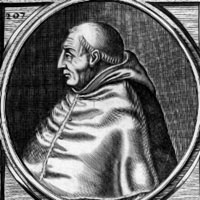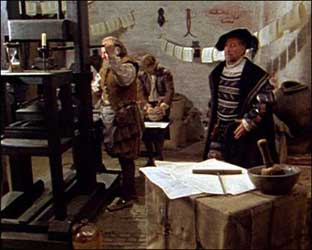| |
Saint
Martin Luther and Usury!! |
|
Just
in time for Reformation Day on Oct. 31. |
|
This
exposé is under construction |
In
his sermon on usury, the GREAT Martin Luther said this about a
zinkskauf or a new form of usury introduced into Germany about
1415 or 100 years before the Reformation:
| "That
can never be right, for by that means one sucks up the other's
blood and sweat. It is no wonder that in these few years that
the zinskauff has been in operation, say
about a hundred years, all principalities and lands have been
impoverished and mortgaged and ruined." |
"No wonder that the zinss contractors quickly become
richer than other people. The others keep their money tied up
in business and hence subject to both kinds of interest, while
the zinss contractors by this little device extricate
themselves from the interest of loss and enter into the first
interest of profit, where their risk is greatly reduced and their
security increased." |
"The
only way of defending this contract against the charge of usury—a
way that would accomplish more than all the talk about interesse—would
be that the zinss contractor should have the same risk
and uncertainty with respect to his zinss as he has with
respect to all his other property." |
Exactly 100 years
before Martin Luther posted the 95 Theses on Oct. 31, 1517,
John Huss the Bohemian reformer was burned at the stake.

John Huss
(1380-1415).
John Huss, a Catholic priest and professor at the university
of Prague was burned at the stake for preaching the Gospel of
Christ. |
|

Burning
of John Huss on July 6, 1415.
John
Huss was burned at the stake for preaching the Gospel of Christ.
Before he was burned he said this to his executioners:"You
are now going to burn a goose, (the name of Huss signifying
goose in the Bohemian language), but in a century you will have
a swan whom you can neither roast nor boil."
|
Saint
Martin Luther was the swan who came exactly 100 years later!!

Martin Luther
(1483-1546).
Martin
Luther, a Catholic priest like John Huss, posted his 95
Theses exactly 100 years after the death of John Huss.
|
|
The
night before Luther posted his famous 95 Theses, the
Elector Frederich the Wise had a strange dream which he related
the next morning:
"Then
I dreamed that all the princes of the Empire, and we among them,
hastened to Rome, and strove, one after another, to break the
pen; but the more we tried the stiffer it became, sounding as
if it had been made of iron. We at length desisted. I then asked
the monk (for I was sometimes at Rome, and sometimes at Wittenberg)
where he got this pen, and why it was so strong. ‘The
pen,’ replied he, ‘belonged to an old goose of Bohemia,
a hundred years old. I got it from one of my old schoolmasters.
As to its strength, it is owing to the impossibility of depriving
it of its pith or marrow; and I am quite astonished at it myself.’
Suddenly I heard a loud noise — a large number of other
pens had sprung out of the long pen of the monk. I awoke a third
time: it was daylight" (The Elector
Frederick's Dream).
|
The
"Bank" of Rome introduced usury on a massive scale into Germany
100 years before the Reformation.
After the death
of John Huss, Satan knew that God planned to launch the Reformation
in 100 years and Germany was to be the blessed land chosen for this
great event. He moved to forestall and destory God's plans.
Legions of monks
and bankers swarmed into Germany. Among them were thousands of fake
"Jews" to do the money lending. A new form of usury was invented
called zinskauf. This involved a contract whereby the produce
of the land was sold at interest or a kind of futures trading.The end
result was to concentrate all the wealth in the hands of a few people
. . . just like today:
"As the Church
gradually acquired a disproportionate share of the wealth of Europe,
not only in lands but in money, it became more oftener a lender of
money than a borrower and it had little difficulty in evading the
prohibition of usury in the profitable employment of its capital.
It would make loans to a needy noble on the security of his lands,
taking a so-called census or ground-rent of one mark for
every ten or twelve or fourteen paid down, the borrower being at any
time entitled to pay off the debt, while the lender renounced the
right to call it in. These arrangements were especially common in
Germany, where they acquired the name of contractus Germanici.
They were plainly usurious according to all the definitions of usury,
but, when, about 1425, some nobles of Silesia endeavored to repudiate
their obligations on that score, the clergy of Breslau appealed to
Pope Martin V, representing that such contracts had been customary
for a time beyond the memory of man, and that the funds of the churches
and canonries were largely invested in them: more than two thousand
altars being thus employed. Pope Martin lent a favourable
ear to the appeal and pronounced such contracts lawful and liable
to enforcement if contested. In 1455 a similar appeal from
the Bishop of Merseburg came to Calixtus III, and met the same favourable
response" (H. C. Lea, Ecclesiastical Treatment of Usury).

Pope Martin
V (1368-1431).
Pope Martin
V, (Pope from 1417-1431) issued a Bull in 1425 sanctioning the
zinss contract or zinskauf
|
|
Pope
Martin V issued a papal Bull authorizing the zinskauf or
ground-rent scam. This was just a very cleverly disguised
usury which in 100 years concentrated all the wealth into the
hands of a few people.
That was the
state of Germany when Martin Luther began the Reformation. Of
course he had to contend with Rome's bankers and fake "Jews"
who actually tried to convert him to "Judaism." |
The
printing press was God's secret weapon to defeat the "Bank"
of Rome.
|
|
|
!00
years after the martyrdom of John Huss, the "Bank" of
Rome had a financial stranglehold on Germany and ALL of Europe.
God's secret
weapon to break this iron grip was the printing press. The
little town of Wittenberg became the literal printing capital
of the world as Luther produced an astonishing amount of Bibles,
books and pamphlets.
Considering
the fact that all writing, typesetting, printing, and binding
was done by hand this truly was a miraculous, supernatural
accomplishment.
|
Saint
Martin Luther was an ARMY OF ONE at Wittenberg!!
The
Great Martin Luther was an army of ONE at Wittenberg: Bible translator,
reformer, professor, author, printer, publisher, theologian, musician,
songwriter, prayer-warrior, preacher, pastor and last but not least
loving husband and father of 4 children....His Complete Works
number over 100 volumes!!
Reference
Gillette,
E.H., The Life & Times of John Hus, in 2 volumes, Gould
& Lincoln, Boston, 1963.
Hartsough,
Mildred, (Translator) Jacob Fugger the Rich, Merchant & Banker
of Augsburg (1429 -1525), The Adelphi Co., New York, 1931.
Lea,
H.C., The Ecclesiastical Treatment of Usury, Yale Law Review,
Feb., 1894.
Luther's
Works, Volume
45, Edited by Jaroslav Pelikan, Concordia Publishing House, St. Louis,
MO, 1955
Schaff,
David, S., John Hus: His Life,Teachings & Death after 500 Years,
Charles Scribner's Son, New York, 1915.
Back
to Main Menu |




